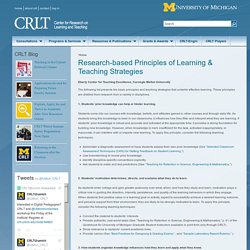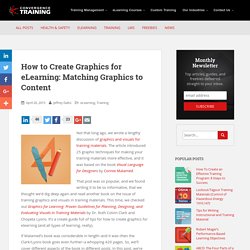

Research for Practitioners: Are There Basic Principles Across All Instructional Design Models? by Angela van Barneveld : Learning Solutions Magazine. 10 Practical Principles for Creating Powerful e-Learning Designs - Allen Interactions. GuidetoCourseDesignAug05. Research-based Principles of Learning & Teaching Strategies. Eberly Center for Teaching Excellence, Carnegie Mellon University The following list presents the basic principles and teaching strategies that underlie effective learning.

These principles are distilled from research from a variety in disciplines. 1. Students’ prior knowledge can help or hinder learning. Students come into our courses with knowledge, beliefs, and attitudes gained in other courses and through daily life. 2. As students enter college and gain greater autonomy over what, when, and how they study and learn, motivation plays a critical role in guiding the direction, intensity, persistence, and quality of the learning behaviors in which they engage. Connect the material to students’ interests. 3. Students naturally make connections between pieces of knowledge. Provide students with the organizational structure of the course. 4. Provide isolated practice of weak or missing skills. 5. 6. Make uncertainty safe. 7. Check students’ understanding of the task. References. Rosenshine. Self-Directed Learning: A Four-Step Process.
JHarris PrinciplesofEffectiveOnlineInstructionReflection. Cschwiebert 7POnline. 6 Teaching Principles Transferred To Online Courses: Strategies To Use - eLearning Industry. 06 19. Center for Teaching Excellence – University of Virginia. Overview To enrich the resources for measuring the impact of educational development work, we have created a rubric to assess the degree to which a syllabus achieves a learning orientation.

The rubric provides qualitative descriptions of components that distinguish learning-focused syllabi and uses a quantitative scoring system that places syllabi on a spectrum from content-focused to learning-focused. It is flexible enough to accommodate a diverse range of levels, disciplines, institutions, and learning environments yet nuanced enough to provide summative information to developers using the tool for assessment purposes and formative feedback to instructors interested in gauging the focus of their syllabi. Our syllabus rubric was awarded the 2014 POD Network Innovation Award. Here’s the project summary created for the annual conference in Dallas, TX: POD Innovation Award Poster. Palmer, M. Figure 1. Total post-CDI scores range from 12.5 to 46 points (1 syllabus).
Figure 2. Designing Significant Learning Experiences. Here are some documents with ideas and information that may be valuable to anyone trying to design their courses.

The items shown in dark blue are links to documents. These are organized around the main tasks in Fink’s Model of Integrated Course Design. The first first step in the process of designing a course is to gather information about various “Situational Factors”. The link below gives a list of factors that sometimes affect the decisions we make in the design process. Information about the “Specific Context” will always be important. Situational Factors to Consider When Designing a Course. Form PossibleTeachingStratforT.O.Course. Firstprinciplesbymerrill. Principles of Adult Learning. 10-Principles-for-Successful-E-learning. Learngin Design Principles Tool. Learning Design Principles. Pearson Shares Its Learning Design Principles by Pamela S. Hogle : Learning Solutions Magazine. Ajet2014esam002.
Dr Maria Georgiou: The ASSURE Learning Model. The ASSURE Learning Model A good strategy for dealing with the new instructional media and technologies is to develop a planning framework to assist in determining when it is appropriate to use these technologies instead of reacting to their integration and use into the educational environment, and one useful mechanism of planning is the ASSURE model (Aziz, 2003).

The primary goal of teachers is to meet the unique needs of each student so they can achieve maximum levels of learning and the ASSURE model provides teachers with a systematic approach for analyzing the characteristics of students that impact their ability to learn while also, the analysis provides information that enables you to strategically plan lessons tailored to meet the specific needs of your students (Smaldino, Heinich, Molenda & Russel, 2008). The first step in the ASSURE model involves analyzing learners. The fifth step involves requiring learner participation in the learning process.
How to Create Graphics for eLearning: Matching Graphics to Content. Not that long ago, we wrote a lengthy discussion of graphics and visuals for training materials.

The article introduced 25 graphic techniques for making your training materials more effective, and it was based on the book Visual Language for Designers by Connie Malamed. That post was so popular, and we found writing it to be so informative, that we thought we’d dig deep again and read another book on the issue of training graphics and visuals in training materials. This time, we checked out Graphics for Learning: Proven Guidelines for Planning, Designing, and Evaluating Visuals in Training Materials by Dr. Ruth Colvin Clark and Chopeta Lyons. It’s a create guide full of tips for how to create graphics for elearning (and all types of learning, really). If Malamed’s book was considerable in length–and it was–then the Clark/Lyons book goes even further–a whopping 420 pages. Why Use Graphics in Training Materials? This may seem obvious, but let’s start at the beginning. Six Principles of Effective e-Learning: What Works and Why by Ruth Clark.
"For the past ten years, Richard Mayer and his colleagues at the University of California at Santa Barbara have conducted a series of controlled experiments on how to best use audio, text, and graphics to optimize learning in multimedia.

Six media element principles can be defined based on Mayer’s work. What follows is a summary of these principles along with supporting examples, psychological rationale, and research. " Take any e-Lesson — show it to five people and ask them what they think. My bet is you will get five different opinions about the quality of the courseware. But, wait! Idea Paper 42. Curriculum-Approaches-in-Language-Teaching. Backward%20design. Designing Significant Learning Experiences. Design, not technology: part 1 of 5. 8183227679_ae1fc2d4d8_c.jpg (JPEG Image, 800 × 600 pixels) Instructional_design:discovery_learning [Learning Theories] General What is discovery learning?
![instructional_design:discovery_learning [Learning Theories]](http://cdn.pearltrees.com/s/pic/th/instructional-discovery-108999923)
In contrast to classical teaching methods in which the learner is usually passive and expected to assimilate the knowledge presented by the teacher1), discovery learning offers a learner-centered approach in which the learner discovers new knowledge through active, hand-on experiences2) and construct new concepts based on his existing knowledge.
SevenPrinciples.pdf.